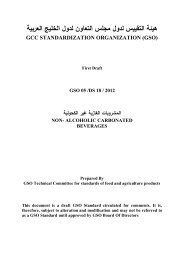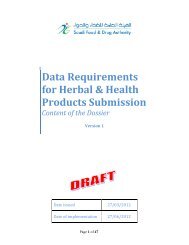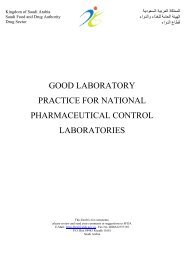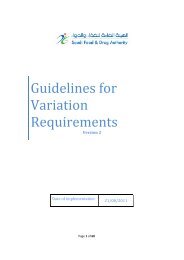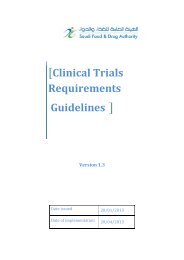The GCC Guidance for Presenting the SPC, PIL and Labeling ...
The GCC Guidance for Presenting the SPC, PIL and Labeling ...
The GCC Guidance for Presenting the SPC, PIL and Labeling ...
- No tags were found...
Create successful ePaper yourself
Turn your PDF publications into a flip-book with our unique Google optimized e-Paper software.
4. Print colorAccessibility is not only determined by print size. Characters may be printed in one or severalcolors allowing <strong>the</strong>m to be clearly distinguished from <strong>the</strong> background. A different type size orcolor is one way of making headings or o<strong>the</strong>r important in<strong>for</strong>mation clearly recognizable.<strong>The</strong> relationship between <strong>the</strong> colors used is as important as <strong>the</strong> colors <strong>the</strong>mselves. As a generalrule dark text should be printed on a light background. But <strong>the</strong>re may be occasions when reversetype (light text on a dark background) could be considered to highlight <strong>for</strong> instance particularwarnings. In such circumstances <strong>the</strong> quality of <strong>the</strong> print will need careful consideration <strong>and</strong> mayrequire <strong>the</strong> use of a larger type size or bold text. Similar colors should not be used <strong>for</strong> <strong>the</strong> text<strong>and</strong> background as legibility is impaired.5. SyntaxSome people may have poor reading skills, <strong>and</strong> some may have poor health literacy. Aim to usesimple words of few syllables.Long sentences should not be used. It is better to use a couple of sentences ra<strong>the</strong>r than one longersentence, especially <strong>for</strong> new in<strong>for</strong>mation.Long paragraphs can confuse readers, particularly where lists of side effects are included. <strong>The</strong>use of bullet points <strong>for</strong> such lists is considered more appropriate. Where possible, no more thanfive or six bullet points in a list are recommended.When setting out <strong>the</strong> side effects it is particularly important to consider <strong>the</strong> order in which <strong>the</strong>yare given so <strong>the</strong> patients/users may maximize <strong>the</strong> use of <strong>the</strong> in<strong>for</strong>mation. In general, setting out<strong>the</strong> side effects by frequency of occurrence, starting with <strong>the</strong> highest frequency, is recommendedto help communicate <strong>the</strong> level of risk to individuals. Frequency terms should be explained in away patients/users can underst<strong>and</strong> – <strong>for</strong> example “very common” (more than 1 in 10 patients).However, where a serious side effect exists which would require <strong>the</strong> patient/user to take urgentaction this should be af<strong>for</strong>ded greater prominence <strong>and</strong> appear at <strong>the</strong> start of <strong>the</strong> section. Settingside effects by organ/system/class is not recommended since patients/users are in general notfamiliar with <strong>the</strong>se classifications.Page 45 of 52




